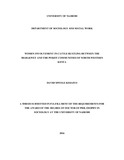| dc.description.abstract | Cattle rustling between the Nilotic communities of north western Kenya has been a problem of concern to development for long and has also defined inter-ethnic relations. There is plenty of literature on cattle rustling; however, the role women play has not been adequately researched. This study was designed to investigate the role played by women among the Pokot and Marakwet communities in cattle rustling. The specific objectives of the study were to investigate the changing faces of cattle rustling, to document the cultural processes and practices in cattle rustling, to establish the perceptions of women regarding cattle rustling, to establish the roles of Pokot and Marakwet women in cattle rustling, and to determine how the agro-pastoralist Marakwet women and pastoralist Pokot women adjust to the effects of cattle rustling.
The study reviewed literature based on key themes on cattle rustling: the global view of cattle rustling, cattle rustling in the colonial period in Kenya, cattle rustling and the state, women and cattle rustling, emerging trends in cattle rustling, and the rise of violent cattle rustling. However, it is clear that the literature does not capture the role women play in the phenomenon.
The theoretical approaches that were utilized are Marxist feminist theory, human ecology theory, and conflict theory. All of them were analyzed to show their relevance to the understanding of the role of women in cattle rustling.
The study was undertaken in Kerio Valley which is the region in which the Pokot of Baringo and West Pokot counties interact with the Marakwet of Elgeyo Marakwet County. A cross-sectional design was employed in which a total of 284 household heads were interviewed out of the targeted 300 household heads. Key informant interviews, focus group discussions, and observation were complementary methods of data collection. Descriptive and inferential statistics were used in data analysis in order to bring out the significant differences and similarities between Pokot and Marakwet women with respect to their participation in cattle rustling.
The findings of the study were that there were significant changes in the conduct of cattle rustling, especially in the use of highly sophisticated small arms and light weapons, the scale of operations, and the increasingly active role played by women. Cultural practices in which women played key roles were a precursor to cattle rustling. On the perceptions of women regarding cattle rustling, most women were dissatisfied with it because of inadequate benefits from it and the suffering they were subjected to. The study also found out that women were deeply engaged in marketing of rustled cattle as well as providing intelligence and concealment of information.
The study concluded that there was a significant difference between the participation of Marakwet and Pokot women in cattle rustling. Pokot women were deeply engaged in cattle rustling as opposed to Marakwet women. For instance, more Marakwet women had embraced crop farming and informal businesses compared with Pokot women.
The study recommends the introduction of modern education in both communities to counter the prevalence of outdated cultural practices, adoption of dairy cattle, peace efforts, promotion of alternative livelihood systems, adoption of a framework for reduction and subsequent elimination of illegal small arms and light weapons, and need to sensitize the Marakwet and Pokot communities on constitutional underpinnings and the existing legal regime regarding cattle rustling. | en_US |



